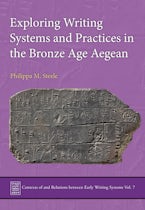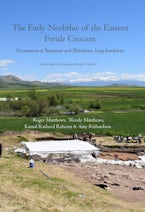Deeply nestled in the rift valley, the hundreds of tombs and extensive remains of the Nabataean metropolis that was once that nation’s capital city of Petra, evokes a sense of geographic protection and isolation from the outside world. With its sprawling development, Petra became a bustling city with exciting and distinctive architectural and artistic styles as the Petraeans determined what a resplendent capital with a burgeoning population and assured economic future should represent. This third volume devoted to one of its most impressive edifices, the Great Temple, builds on the previous two volumes of excavation reports to examine many facets of Nabataean material culture. It exposes a cross-section of the material culture, from water-supply systems and architectural designs to studies of artifacts (sculpture, ceramics, numismatics, metal and bone) and subsistence patterns.
Part I explores the principles of the temple layout and how it was built including Nabataean construction techniques, hydraulic systems, decoration, art and and subsidiary buildings of the precinct.
Part II is devoted to additional aspects of Nabataean material culture, with chapters devoted to the site databases, ceramics and Nabataean potting traditions, lamps, figurines, glass, coins, faunal and worked bone analyses, metal objects, ballista balls, and sculpture.
The volume is supported by an online database http://www.opencontext.org designed to assemble special research materials that could not be published here in print which provides the tools for researchers to perform their own analysis of the data.
Contents
Addresses of contributors
General Abbreviations
List of Figures
List of Tables and Charts
Foreword
G. W. Bowersock
Preface and Acknowledgments
M. S. Joukowsky
1. The Great Temple, 1993–2008: a brief review of the excavations, stratigraphy and phasing
M. S. Joukowsky
2. Surveying at the Great Temple, 1993–2009
M. C. Agnew and F. R. Ishakat
Part I: Architecture
3. Construction techniques of the Great Temple: how the temple was reconstructed
S. M. Rababeh
4. The water systems of the Great Temple
C. F. Cloke
5. Moulded elegance: analysis and interpretation of the stucco revetments from the Great Temple
E. C. Egan
6. Sculpted relief panels from the Great Temple
J. J. Basile
7A. The Corinthian columns of the Great Temple and the plants associated with Dionysus
A. M. Hussein
7B. The elephant-head capitals of the Triple colonnades in the Lower Temenos
M. S. Joukowsky
8. Theater-in-Temple
R. Frederiksen
9. The Roman-Byzantine baths adjacent to the Great Temple
E. A. Power
Part II: Material culture
10. An introduction to the catalogue of objects
D. G. Barrett
11. An overview of the ceramic assemblage from the Residential Quarter
S. L. Saunders
12. Terracotta lamps
D. G. Barrett
13. The coroplastic artifacts: terracotta figurines, plaques, masks and vessels
C. A. Tuttle
14. The glass (1998–2006)
M. O’Hea
15. Coins from the Great Temple excavations: an overview
C. F. Cloke
16. Inscriptions
T. Gagos
17A. Food production and procurement in residential areas at the Great Temple
S. Whitcher Kansa
17B. Fish remains
R. Cerón-Carrasco
17C. Human skeletal remains (2000–2003)
M. A. Perry
18A. The worked bone objects
M. S. Joukowsky and Etan Ayalon
18B. A bone handle in the form of a leg from the Residential Quarter
M. S. Joukowsky, Sarah Whitcher Kansa, Francois Poplin, Dávid Bartus and Donna Strahan
18C. A worked hippopotamus tusk
M. S. Joukowsky
19. “Mettle Enough in Thee” metal artifacts from the Petra Great Temple
A. Murock Hussein
20. A store of ballista balls
M. S. Joukowsky
21. Nefesh, betyls and miscellaneous sculpture components
M. S. Joukowsky
22. Summary and conclusions
M. S. Joukowsky
Appendices
1. Great Temple List of Trenches and Special Projects by Area
2. Dimensions and Elevations: Great Temple Precinct
3. Database Methodology and Results
4. Great Temple Ceramics
5. Great Temple Architectural Fragments
Bibliography
Site Bibliography
Illustration credits
Index
Martha Sharp Joukowsky was Professor Emerita of Old World Archaeology and Art and Anthropology at the Jouwkwsky Insitute for Archaeology and the Ancient world at Browns University, Providence RI. She was trained as a Middle Eastern archaeologist. Her primary research interests were in Nabataean cultural history and she directed 10 years of excavations at the Petra Great Temple in Jordan. Her other wide ranging research interests included the domestication of plants and animals, the advent of Middle East urbanism, and the varied cultural developments in Anatolia, Syro-Palestine, Mesopotamia, and ancient Iran, from the earliest times to the Hellenistic and Roman periods.












